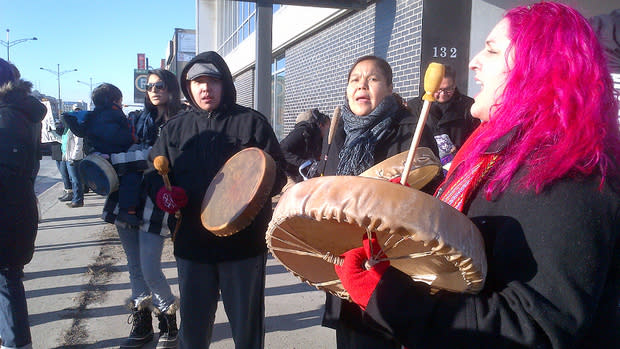 Daily Brew
Daily BrewAttawapiskat First Nation members continue blockade of ice road to remote diamond mine

Attawapiskat, for the most part has been out of the news since Chief Theresa Spence ended her hunger strike in Ottawa last month, but that doesn't mean things aren't happening at the remote northern Ontario First Nations community.
Some members of the James Bay Cree community are in a legal and physical standoff with diamond-mining giant De Beers Canada over operation of its Victor mine, about 90 kilometres west of the settlement.
Residents have been blockading an ice road used to deliver supplies to the $1-billion mine for more than a week. They say local aboriginal people have not received their fair share of jobs and other economic benefits from the diamond-mining operation, something the company disputes.
[ Related: Attawapiskat unrest continues, despite De Beers investment ]
The company won a court injunction Friday ordering the blockade to be taken down but on Saturday, Spence met the sheriff delivering the ruling at the airport and handed him a letter that forbade him from setting foot in Attiwapiskat, APTN News reported.
After consulting with Ontario Provincial Police officers, the sheriff left but apparently returned a few hours later and planted the injunction notice on a stake in the snow near the blockade site. APTN reported blockade supporter Bruce Shisheesh ripped out the stake and threw it into the trees.
“They left and we assumed they took our letter seriously and respectfully, but that didn’t happen,” Spence told APTN. “To see that notice, for them to come in unexpectedly and sneakily, to me, they don’t understand our way and they don’t respect our ways … It is very disturbing.”
De Beers spokesman Tom Ormsby told QMI Agency that as of Monday the blockade was still in place.
The road is vital to the mine's operation because there's only a 45-day window to deliver supplies and equipment need for the next year, QMI Agency reported.
Blockader Rebecca Iahtail told APTN that the injunction arrived as the blockaders had reached a tentative agreement with De Beers to end the protest after a conference call Saturday.
“We told them there was an agreement between us and De Beers but they still came with that notice there," she said. "I think it is a serious thing. They already broke their promise. I am going to go with what my supporters say.”
The deal called for a joint dispute-resolution committee to address issues such as employment, training, housing and the need to compensate those whose traplines are located in and around the mine site, APTN reported.
Spence said the Attiwapiskat First Nation wants the problem resolved so it can discuss future exploration projects on its traditional territory.
[ Related: Was Chief Theresa Spence's hunger strike worth it? ]
Spence made national headlines for a six-week hunger strike where she lived on water, tea and fish broth on an island in the Ottawa River. She had been demanding a meeting with Prime Minister Stephen Harper and Governor General David Johnston to address a long list of aboriginal grievances.
Her protest coincided with the surge in protests by the grassroots Idle No More movement aimed at pressuring the federal government on a wide range of issues such as substandard housing and education opportunities on reserves.
Spence ended her hunger strike after Harper met with chiefs from the Assembly of First Nations, beginning a series of sessions to address longstanding problems.
Her protest was in part overshadowed by the release of an auditor's report that concluded there was little or no record of how Attiwapiskat had spent about $104 million in federal funding on the impoverished reserve between April 2005 and November 2011.


